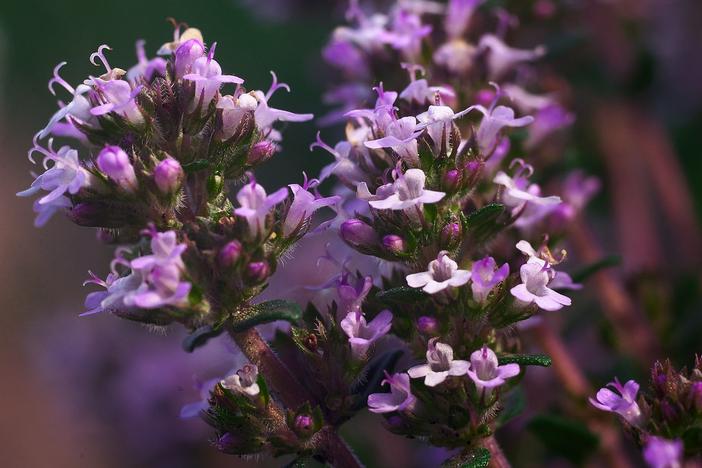Common Thyme
(Thymus vulgaris)
Common Thyme (Thymus vulgaris)
/
/

Ralf Wimmer
CC BY 2.0
Image By:
Ralf Wimmer
Recorded By:
Copyright:
CC BY 2.0
Copyright Notice:
Photo by: Ralf Wimmer | License Type: CC BY 2.0 | License URL: https://creativecommons.org/licenses/by/2.0/ | Uploader: g e g e n l i c h t | Publisher: Flickr












































































Estimated Native Range
Summary
Thymus vulgaris, commonly known as common thyme or garden thyme, is an evergreen subshrub in the mint family Lamiaceae, native to the dry, rocky areas of the Mediterranean region, from western Mediterranean to southern Italy. It typically grows to 15–30 cm (6–12 in) tall and spreads up to 40 cm (16 in) wide. Thymus vulgaris forms a bushy mound with woody stems, small, highly aromatic, grey-green leaves, and clusters of purple or pink flowers that bloom in early summer. The flowers are modest in size but can be quite attractive to bees and other pollinators.
Garden thyme is valued for its fragrance, culinary uses, and ornamental qualities. It is a key herb in various cuisines and is used for seasoning a wide range of dishes. The plant’s essential oils have also been used in herbal medicine. As a groundcover, it can fill in spaces between stepping stones or in rock gardens, providing a pleasant aroma when stepped on. Thymus vulgaris thrives in full sun and well-drained soil, tolerating drought once established. It is generally low-maintenance but benefits from occasional trimming to promote bushy growth. While it can be short-lived, it is easily propagated from cuttings or division. Be aware that in some regions outside its native range, it may become invasive, so it’s important to check local guidelines before planting.CC BY-SA 4.0
Garden thyme is valued for its fragrance, culinary uses, and ornamental qualities. It is a key herb in various cuisines and is used for seasoning a wide range of dishes. The plant’s essential oils have also been used in herbal medicine. As a groundcover, it can fill in spaces between stepping stones or in rock gardens, providing a pleasant aroma when stepped on. Thymus vulgaris thrives in full sun and well-drained soil, tolerating drought once established. It is generally low-maintenance but benefits from occasional trimming to promote bushy growth. While it can be short-lived, it is easily propagated from cuttings or division. Be aware that in some regions outside its native range, it may become invasive, so it’s important to check local guidelines before planting.CC BY-SA 4.0
Plant Description
- Plant Type: Subshrub
- Height: 0.5-1 feet
- Width: 0.5-1 feet
- Growth Rate: Moderate
- Flower Color: Pink, Purple, White
- Flowering Season: Spring, Summer
- Leaf Retention: Evergreen
Growth Requirements
- Sun: Full Sun
- Water: Low, Medium
- Drainage: Medium
Common Uses
Bee Garden, Bird Garden, Border Plant, Butterfly Garden, Deer Resistant, Drought Tolerant, Edible*Disclaimer: Easyscape's listed plant edibility is for informational use. Always verify the safety and proper identification of any plant before consumption., Fire Resistant, Fragrant, Groundcover, Low Maintenance, Potted Plant, Rabbit Resistant, Rock Garden, Salt Tolerant, Street Planting
Natural Habitat
Native to dry, rocky areas of the Mediterranean region
Other Names
Common Names: German Thyme, English Thyme, Thyme, Common Thyme, Have-Timian, Thymian, Tomillo, Tomillo Común, Tarha-Ajuruoho, Timjami
Scientific Names: , Thymus vulgaris, Origanum thymus, Thymus collinus,
GBIF Accepted Name: Thymus vulgaris L.